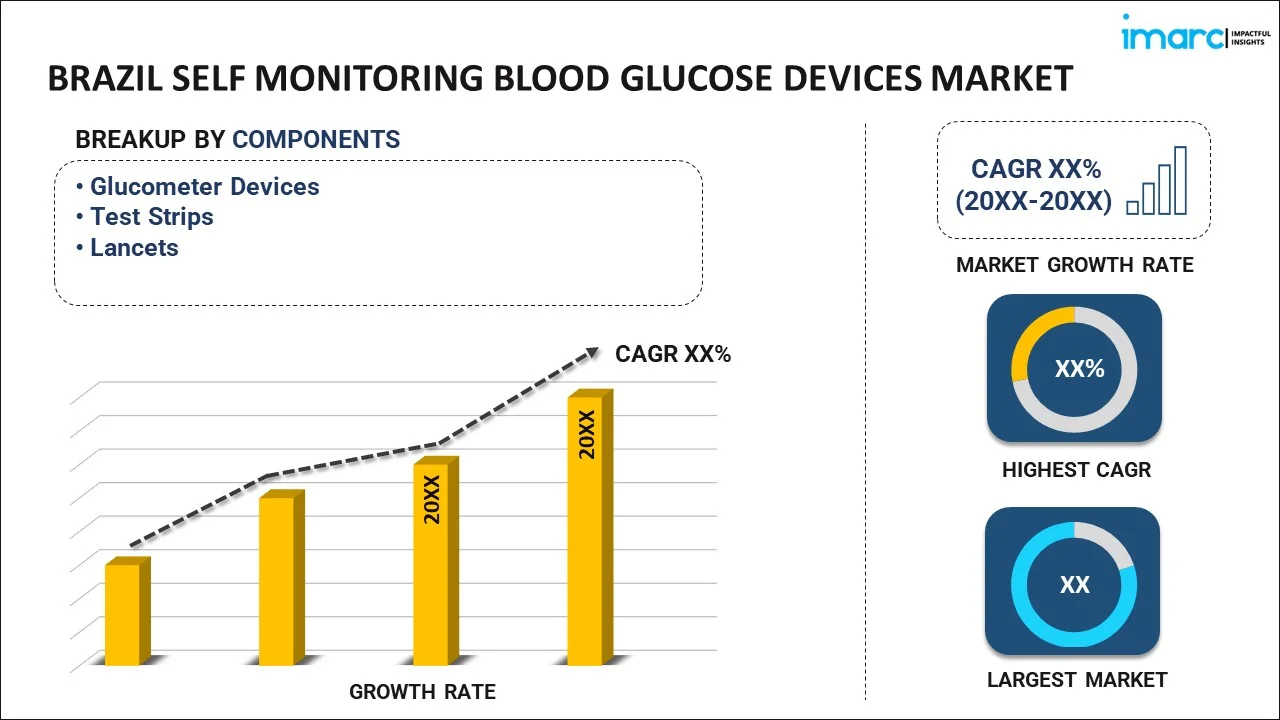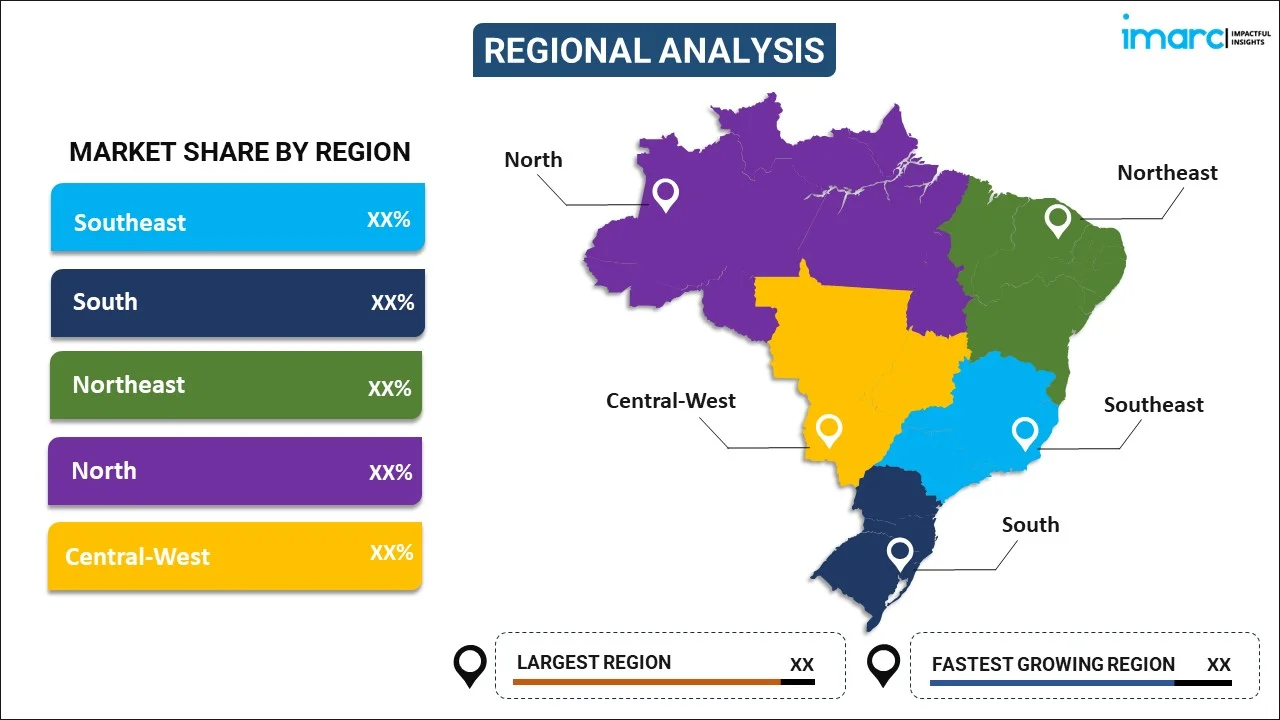
Brazil Self Monitoring Blood Glucose Devices Market Report by Component (Glucometer Devices, Test Strips, Lancets), and Region 2025-2033
Market Overview:
Brazil self monitoring blood glucose devices market size reached USD 315 Million in 2024. Looking forward, IMARC Group expects the market to reach USD 466 Million by 2033, exhibiting a growth rate (CAGR) of 4.5% during 2025-2033. The increasing prevalence of diabetes within the country, the widespread adoption of self-monitoring tools for effective disease management, integration of digital technology to smartphones and healthcare applications, and the advent of less invasive or non-invasive monitoring options represent some of the key factors driving the market.
|
Report Attribute
|
Key Statistics
|
|---|---|
|
Base Year
|
2024
|
|
Forecast Years
|
2025-2033
|
|
Historical Years
|
2019-2024
|
|
Market Size in 2024
|
USD 315 Million |
|
Market Forecast in 2033
|
USD 466 Million |
| Market Growth Rate 2025-2033 | 4.5% |
Self monitoring blood glucose evices are specialized medical instruments designed to enable individuals to measure their blood glucose levels conveniently and accurately. These devices are highly valuable for people with diabetes, providing immediate feedback on blood sugar levels thereby assisting in better management of the condition. There are primarily two types of SMBG devices: glucometers, which are portable handheld devices that usually involve pricking the finger to obtain a blood sample, and continuous glucose monitors, which involve a sensor placed under the skin to provide continuous real-time glucose readings. Both these types offer digital displays for instant results and have data storage capabilities for tracking trends over time. Additionally, the primary advantage of SMBG devices is the empowerment of patients to actively engage in their healthcare by monitoring glucose levels in real-time. This helps in making informed decisions about diet, exercise, and medication and enables timely interventions to prevent extreme glucose fluctuations. By providing instant readings, these devices minimize the risk of severe hypoglycemia or hyperglycemia episodes. Moreover, many modern SMBG devices come with features such as wireless connectivity to smartphones and healthcare apps, making it easier for healthcare providers to monitor patient data remotely.
Brazil Self Monitoring Blood Glucose Devices Market Trends:
The market in Brazil is majorly driven by the expansion of the healthcare sector. One of the most significant drivers is the escalating prevalence of diabetes within the country, compelling individuals to adopt self-monitoring tools for effective disease management. As awareness grows concerning the critical importance of real-time blood glucose monitoring for preventing complications, demand for these devices is increasing. Another influencing factor is Brazil's developing healthcare infrastructure, coupled with government initiatives to enhance public awareness about diabetes care, which is helping to bolster market penetration for SMBG devices. Along with this, technological advancements in these monitoring systems are also playing a vital role in driving market growth. The integration of digital technology, including Bluetooth connectivity to smartphones and healthcare applications, allows both patients and healthcare providers to track and analyze glucose levels more efficiently, thereby ensuring timely interventions. In addition, artificial intelligence capabilities in some devices can predict glucose trends, which is a significant value addition for users. Moreover, patient compliance has improved with the advent of less invasive or non-invasive monitoring options. Apart from this, the market is experiencing a trend towards eco-friendly and sustainable products, mirroring global shifts towards sustainability. Biodegradable components and eco-friendly manufacturing processes are increasingly being adopted by manufacturers, further broadening the appeal of these devices. Furthermore, the accelerating awareness and a focus on sustainability are creating a positive market outlook.
Brazil Self Monitoring Blood Glucose Devices Market Segmentation:
IMARC Group provides an analysis of the key trends in each segment of the market, along with forecasts at the country level for 2025-2033. Our report has categorized the market based on component.
Component Insights:

- Glucometer Devices
- Test Strips
- Lancets
The report has provided a detailed breakup and analysis of the market based on the component. This includes glucometer devices, test strips, and lancets.
Regional Insights:

- Southeast
- South
- Northeast
- North
- Central-West
The report has also provided a comprehensive analysis of all the major regional markets, which include Southeast, South, Northeast, North, and Central-West.
Competitive Landscape:
The market research report has also provided a comprehensive analysis of the competitive landscape in the market. Competitive analysis such as market structure, key player positioning, top winning strategies, competitive dashboard, and company evaluation quadrant has been covered in the report. Also, detailed profiles of all major companies have been provided. Some of the key players include:
- Abbott Laboratories
- Ascensia Diabetes Care Holdings AG (PHC Holdings Corp.)
- Roche Diabetes Care
(Please note that this is only a partial list of the key players, and the complete list is provided in the report.)
Brazil Self Monitoring Blood Glucose Devices Market Report Coverage:
| Report Features | Details |
|---|---|
| Base Year of the Analysis | 2024 |
| Historical Period | 2019-2024 |
| Forecast Period | 2025-2033 |
| Units | Million USD |
| Scope of the Report | Exploration of Historical and Forecast Trends, Industry Catalysts and Challenges, Segment-Wise Historical and Predictive Market Assessment:
|
| Components Covered | Glucometer Devices, Test Strips, Lancets |
| Regions Covered | Southeast, South, Northeast, North, Central-West |
| Companies Covered | Abbott Laboratories, Ascensia Diabetes Care Holdings AG (PHC Holdings Corp.), Roche Diabetes Care, etc. |
| Customization Scope | 10% Free Customization |
| Post-Sale Analyst Support | 10-12 Weeks |
| Delivery Format | PDF and Excel through Email (We can also provide the editable version of the report in PPT/Word format on special request) |
Key Questions Answered in This Report:
- How has the Brazil self monitoring blood glucose devices market performed so far and how will it perform in the coming years?
- What has been the impact of COVID-19 on the Brazil self monitoring blood glucose devices market?
- What is the breakup of the Brazil self monitoring blood glucose devices market on the basis of component?
- What are the various stages in the value chain of the Brazil self monitoring blood glucose devices market?
- What are the key driving factors and challenges in the Brazil self monitoring blood glucose devices?
- What is the structure of the Brazil self monitoring blood glucose devices market and who are the key players?
- What is the degree of competition in the Brazil self monitoring blood glucose devices market?
Key Benefits for Stakeholders:
- IMARC’s industry report offers a comprehensive quantitative analysis of various market segments, historical and current market trends, market forecasts, and dynamics of the Brazil self monitoring blood glucose devices market from 2019-2033.
- The research report provides the latest information on the market drivers, challenges, and opportunities in the Brazil self monitoring blood glucose devices market.
- Porter's five forces analysis assist stakeholders in assessing the impact of new entrants, competitive rivalry, supplier power, buyer power, and the threat of substitution. It helps stakeholders to analyze the level of competition within the Brazil self monitoring blood glucose devices industry and its attractiveness.
- Competitive landscape allows stakeholders to understand their competitive environment and provides an insight into the current positions of key players in the market.
Need more help?
- Speak to our experienced analysts for insights on the current market scenarios.
- Include additional segments and countries to customize the report as per your requirement.
- Gain an unparalleled competitive advantage in your domain by understanding how to utilize the report and positively impacting your operations and revenue.
- For further assistance, please connect with our analysts.
 Inquire Before Buying
Inquire Before Buying
 Speak to an Analyst
Speak to an Analyst
 Request Brochure
Request Brochure
 Request Customization
Request Customization




.webp)




.webp)












